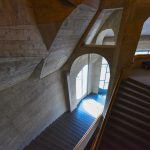7 brand-new stadiums in Qatar
The 2022 FIFA World Cup in Qatar had seven brand new stadiums designed by some of the world’s most famous stadium designers, we take a look! The 2022 FIFA World Cup in Qatar features seven brand-new stadiums, one of which will fully disappear following the nearly month-long event. Some of the world’s best designers have designed the new stadiums. In this article, we break down the architecture behind each that required a mix of cooling technologies, retractable roofs, and shade-offering designs and were inspired by Arab design.
Al Bayt Stadium
Al Khor City
Designed by AS+P Albert Speer + Partner and Dar Al-Handasah
Al Bayt Stadium is meant to resemble a tent historically used by nomadic people in the Qatar and Gulf region, a PTFE (Polytetrafluoroethylene) woven fiberglass membrane includes a retractable roof meant to compliment cooling technologies. Surrounded by green space, it will incorporate a shopping centre, food court, gym, multipurpose hall, and sports medicine hospital.
Lusail Stadium
Lusail City
Designed by Foster + Partners and Populous
The largest stadium for the tournament—and host of the championship match—takes cues from architects Foster + Partners and Populous. Inspired by the light and shadow of a “fanar” lantern, the façade features triangular panels and a steel frame with additional decorations resembling the motifs found on regional artistic bowls.
Ahmad Bin Ali Stadium
Umm Al Afaei
Designed by BDP Pattern, Ramboll, and AECOM
With a glowing façade created by Ramboll and Pattern Design, comprised of patterns important to the region—including the undulations of sand dunes—the 40,000-seat venue that opened in 2020 takes the place of a stadium that once stood in the same spot. More than 90 per cent of the construction materials were reused or recycled from the old stadium, and trees were moved to other locations on the property.
Al Janoub Stadium
Al Wakrah
Designed by Zaha Hadid Architects + AECOM
In a tribute to the city’s seafaring past, the 40,000-seat stadium was inspired by the sails of traditional dhow boats. The retractable roof weighing 416 tons, was built on six temporary frames before being lifted into place and welded together. Steel wires can move the steel structure open and closed.
Al Thumama Stadium
Al Thumama
Designed by Ibrahim Jaidah Architects & Engineers
Meant to represent a gahfiya, the traditional woven cap worn by men and boys across the Middle East, the white exterior stands out against the green surroundings. Designed by architect Ibrahim M. Jaidah, the 40,000-seat venue opened in 2021. The gahfiya design is more than a nod to culture, as the cap-like design was meant to pair with the cooling technology to protect against penetrating sun.
Education City Stadium
Al Rayyan
Designed by Fenwick Iribarren Architects
The façade of the 40,000-seat stadium, designed by Fenwick-Iribarren Architects and Pattern Design, opened in 2020 featuring triangles that form a diamond-like geometrical pattern that appears to change colour with the sun’s movement across the sky. At night, that same façade turns into a digital light show.
Khalifa International Stadium
Aspire
Designed by Dar Al-Handasah
The only existing stadium repurposed for the 2022 World Cup, the stadium was originally built in 1976 but was redeveloped in 2017 by Dar Al-Handasah, the original stadium architect, in preparation for the global stage. The stadium’s dual arches remained intact and were joined by a wide canopy to support the integration of the cooling system. A new tier of 10,450 seats pushed the capacity to 40,000, and a fresh LED lighting system adds to the fan features.
Stadium 974
Ras Abu Aboud
Designed by Fenwick Iribarren Architects
Constructed entirely from 974 shipping containers and modular steel, this becomes the first World Cup Stadium that will be fully removed following the tournament. Designed by Fenwick-Iribarren Architects as a tribute to Qatar’s history in worldwide trade and seafaring, the standard shipping containers offer a colourful array for everything from concessions to stairs, and the modular design reduced material requirements. Many of the materials needed for the venue were brought to the site in the containers now used in the venue. With its location amidst natural wind patterns, the seating bowl for the 2021-opened venue uses breezes instead of cooling technology for ventilation.




GIPHY App Key not set. Please check settings